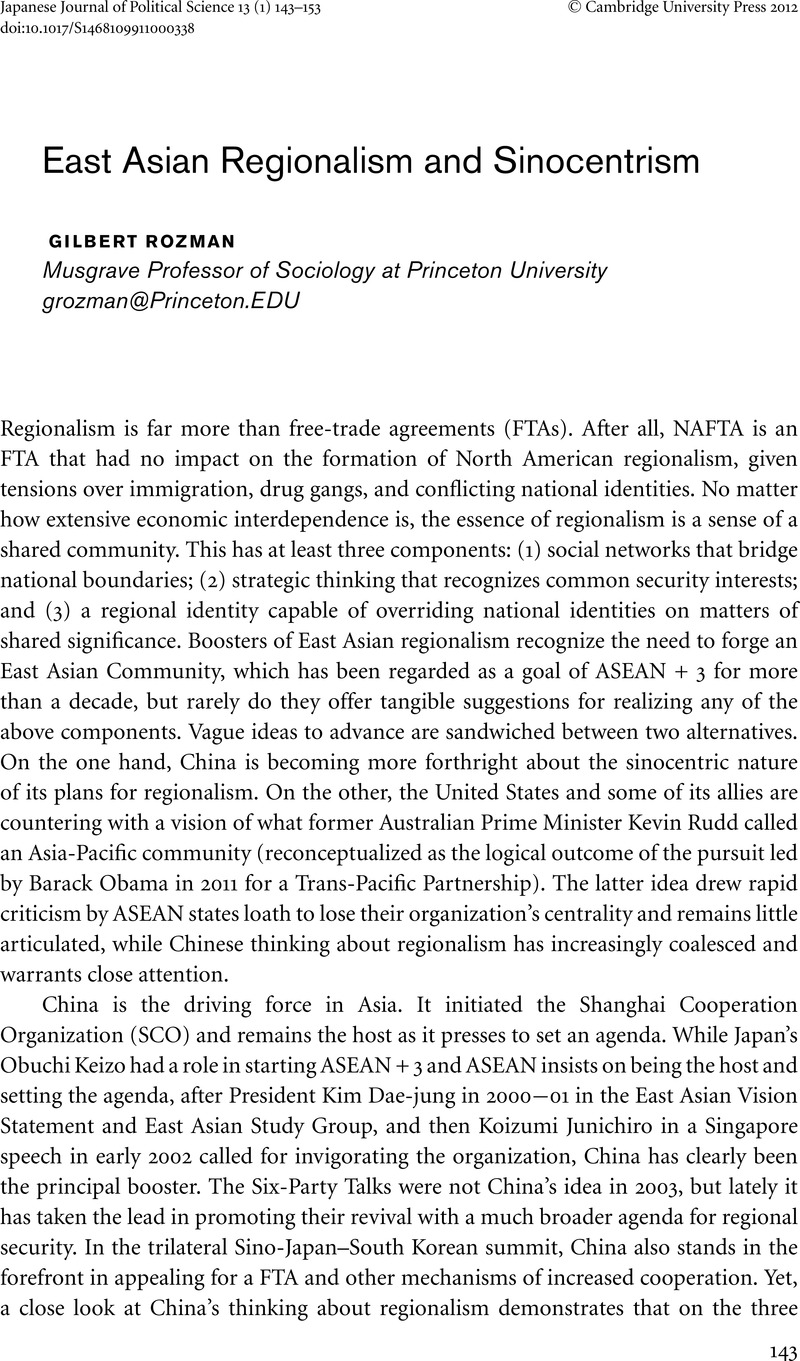Article contents
East Asian Regionalism and Sinocentrism
Published online by Cambridge University Press: 27 January 2012
Abstract

- Type
- Feature Articles: Responses to Special Issue ‘Ideas of Asian Regionalism’, (Japanese Journal of Political Science, Issue 12, Part 2, August 2011)
- Information
- Copyright
- Copyright © Cambridge University Press 2012
References
1 He, Bangang and Inoguchi, Takashi, ‘Introduction to Ideas of Asian Regionalism’, Japanese Journal of Political Science, 12 (2): 165–77CrossRefGoogle Scholar.
2 I have traced Chinese views of regionalism over the past two decades through the following publications: ‘Flawed Regionalism: Reconceptualizing Northeast Asia in the 1990s’, Pacific Review, 11(1) (1998): 1–27; Northeast Asia's Stunted Regionalism: Bilateral Distrust in the Shadow of Globalization (Cambridge: Cambridge University Press, 2004); ‘Post Cold War Evolution of Chinese Thinking on Regional Institutions in Northeast Asia’, Journal of Contemporary China, 19(66) (September 2010): 605–20; and ‘Chinese Strategic Thinking on Multilateral Regional Security in Northeast Asia’, Orbis (Spring, 2011): 296–311. I draw on these materials for this response. I also draw on Ch. 7, ‘Chinese National Identity and East Asian National Identity Gaps’, in my edited book, National Identities and Bilateral Relations: Widening Gaps in East Asia and Chinese Demonization of the United States (Washington, DC and Stanford, CA: The Woodrow Wilson Center Press and Stanford University Press, forthcoming).
3 He, Baogang, ‘East Asian Ideas of Regionalism: A Normative Critique’, Australian Journal of International Affairs, 58 (1) (March 2004): 115CrossRefGoogle Scholar.
4 Yunling, Zhang, ‘Dongya quyi hezuo de xin qushi’, Dangdai Yatai, 4 (2009): 4–16Google Scholar.
5 Dongyi, Li, ‘Dongya quyihua ruhe quli yu Meiguo de guanxi: yu Oujou yitihu de duibi fenxi’, Waijiao pinglun, 2 (2010): 82–92Google Scholar.
6 Dianjun, Ba, ‘Cong wenhua shijiao touxi Riben waijiao zhengce de zhanlue xuanze’, Riben xuekan, 4 (2010): 93–106Google Scholar.
7 Xiaoming, Zhang, ‘Meiguo shi Dongya quyi hezuo de tuidongzhe haishi zuaizhe’, Shijie jingji yu zhengzhi, 7 (2010): 4–13Google Scholar.
8 Yuechuan, Wang, ‘Houdongfangzhuyi yu Zhongguo wenhua shenfen’, Lilun yu chuangzuo, 3 (2010): 4–9Google Scholar.
9 Hailong, Ju and Hongliang, Ge, ‘Meiguo “chongfan” Dongnanya dui Nanhai anquan xingshi de yingxiang’, Shijie jingji yu zhengzhi luntan, 1 (2010): 87–97Google Scholar; Yuechuan, Wang, ‘Houdongfangzhuyi yu Zhongguo wenhua shenfen’, Lilun yu chuangzuo, 3 (2010): 4–9Google Scholar.
10 Gilbert Rozman, ‘Chinese National Identity and the Sino-US Civilizational Gap’, in Gilbert Rozman, ed., National Identities and Bilateral Relations, chapter 8.
11 Rozman, Gilbert, Northeast Asia's Stunted Regionalism: Bilateral Distrust in the Shadow of Globalization (Cambridge: Cambridge University Press, 2004)CrossRefGoogle Scholar.
12 Rozman, Gilbert, ‘Northeast Asian Regionalism at a Crossroads: Is an East Asian Community in Sight?’, in Timmermann, Martina and Tsuchiyama, Jitsuo (eds.), Institutionalizing Northeast Asia: Regional Steps towards Global Governance (Tokyo: United Nations University Press, 2008), pp. 196–220Google Scholar.
13 Rozman, Gilbert, ‘Post Cold War Evolution of Chinese Thinking on Regional Institutions in Northeast Asia’, Journal of Contemporary China, 19 (66) (September 2010): 605–20CrossRefGoogle Scholar; Rozman, Gilbert, ‘Japanese Strategic Thinking on Regionalism’, in Rozman, Gilbert (ed.), Japanese Strategic Thought toward Asia (New York: Palgrave, 2007), pp. 243–68CrossRefGoogle Scholar.
14 Rozman, Gilbert, ‘Narrowing the Values Gap in Sino-Japanese Relations: Lessons from 2006–2008’, in Gong, Gerrit and Teo, Victor (eds.), Reconceptualizing the Divide: Identity, Memory, and Nationalism in Sino-Japanese Relations (Cambridge: Cambridge Scholars Publishing, 2010), pp. 25–51Google Scholar.
15 Wang Yuzhu, ‘Yazhou quyi hezuo de lujing jingzheng ji Zhongguo de zhanlue xuanze’, Dangdai Yatai (4) (2010): 73–87.
16 Zhu Tingchang, ‘Lun Zhongguo zai Yatai diqu de quyi zhongxin diwei’, Shijie jingji yu zhengzhi luntan (1) (2010): 76–86.
17 ‘Vietnam–China Joint Statement’, 15 October 2011, People's Army Newspaper Online http://www.silobreaker.com/vietnamchina-joint-statement-5_2264922215453556814 (accessed 22 November 2011).
- 3
- Cited by




